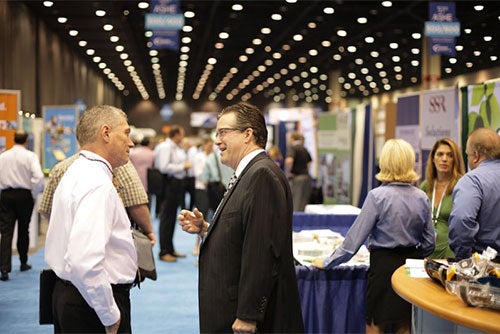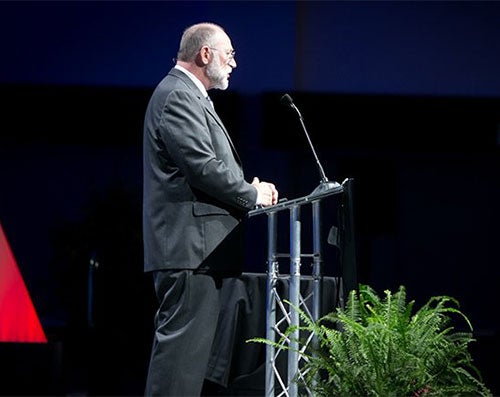Joint Commission announced major changes at ASHE's largest annual conference
The 2016 American Society for Healthcare Engineering (ASHE) Annual Conference held last week in Denver provided an excellent chance for health care facility professionals to stay current on industry regulations and trends and also to see the latest products in the market up close.

This year's ASHE Annual Conference saw record numbers of attendees and exhibitors.
Considering the turnout, the value of those opportunities was apparent to many. With an estimated 4,000 at the show, it was ASHE's highest attendance ever for an annual conference and the 352 exhibitors made it the organization's biggest trade show in annual conference history. Several educational sessions at the show attracted overflow crowds.
The conference is important for another reason, says Dale Woodin, CHFM, FASHE, American Hospital Association vice president, personal membership groups. It gives members and attendees the opportunity to network and collaborate with each other on issues they face on the job.
“We all face the same challenges in today’s rapidly changing health care environment, and having a support system of thousands of people from across the country can help our members find solutions that work for them,” he says.
At the conference George Mills, FASHE, CEM, CHFM, CHSP, director of engineering with the Joint Commission’s Department of Engineering, Oak Brook Terrace, Ill., announced that Centers for Medicare & Medicaid Services (CMS) has asked the Joint Commission to make several changes to its Statement of Conditions process.
Key among them is that starting August 1 the Joint Commission will no longer consider hospital Plans for Improvement (PFIs). Instead, all life-safety deficiencies will need to be corrected within 60 days, although a time-limited waiver process will be available through CMS regional offices.
Under the new process:
- Deficiencies will need to be corrected within 60 days of being identified unless the CMS regional office approves an extension.
- All requests for extensions will be handled by CMS regional offices. However, the Joint Commission will allow facilities to submit requests and receive a receipt to show they are in the pipeline waiting for an extension.
- The Joint Commission will not review open PFI items, and PFIs will not be a part of final reports.
- The Joint Commission is an accrediting organization that has deemed authority from CMS and must meet CMS requirements. Mills said the PFI process can still be used as an internal management process.
Also at the conference several individuals and health care organizations were recognized for their work and accomplishments. The Crystal Eagle award, considered ASHE’s “lifetime achievement” award, was presented to Mark Kenneday, MBA, CHFM, FASHE, CHC, vice chancellor, campus operations, University of Arkansas for Medical Sciences, Little Rock, Ark.
Kenneday, a former ASHE president, has contributed to the field in multiple ways. He authored the Health Facility Commissioning Guidelines and has worked to advocate for better codes and standards regulating hospitals. Kenneday has also inspired and mentored many facility professionals, and has helped promote the value of facility leaders to the C-suite.

George Mills, FASHE, CEM, CHFM, CHSP, director of engineering with the Joint Commission’s Department of Engineering.
The President’s Award, which is presented at the discretion of the sitting ASHE president to an individual who goes above and beyond to optimize the health care physical environment, was given to Michael Hatton, RPA, SMA, SASHE, CHFM, vice president, Memorial Hermann Healthcare System, Houston.
ASHE presented a Professional Service Award to Clark Reed, who directs the Environmental Protection Agency’s Energy Star Healthcare Program, for his efforts in helping hospitals become more energy efficient.
Spaulding Rehabilitation Hospital Boston was named the 2016 Energy Champion for cutting energy use by 15 percent last year. The facility department retrocommissioned the HVAC system and optimized lighting control systems.
“This year’s Energy Champion exemplifies the amazing efficiencies that can occur when hospital leaders, facility professionals and everyone involved in the health care environment work together,” Woodin says.
In addition, 29 hospitals earned an Energy to Care Award for slashing energy use by 10 percent or more over the previous year or an additional 5 percent for previous winners.
“By reducing energy use in health care facilities, all of the Energy to Care Award recipients have provided value to their organizations while allowing additional resources to be directed toward patient care,” Woodin says
Read the full list of Energy to Care Award winners.
ASHE members will get free access to recordings of select conference sessions when they are made available in upcoming weeks.




